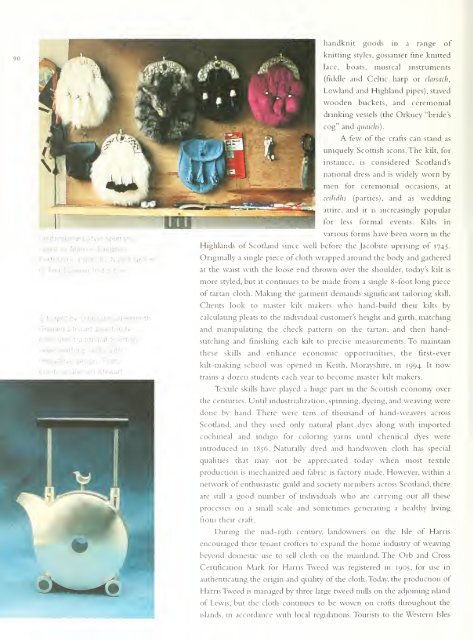SCOTLAND - Smithsonian Digital Repository - Smithsonian Institution
SCOTLAND - Smithsonian Digital Repository - Smithsonian Institution
SCOTLAND - Smithsonian Digital Repository - Smithsonian Institution
You also want an ePaper? Increase the reach of your titles
YUMPU automatically turns print PDFs into web optimized ePapers that Google loves.
.<br />
handknit goods in a range of<br />
90<br />
knitting styles, gossamer fine knitted<br />
lace, boats, musical instruments<br />
Perthshire.<br />
!<br />
© <strong>Smithsonian</strong> <strong>Institution</strong><br />
' jce<br />
(tlddle and Celtic harp or clarsach,<br />
Lowland and Highland pipes), staved<br />
wooden buckets, and ceremonial<br />
drinking vessels (the Orkney "bride's<br />
cog" and quaichs).<br />
A few of the crafts<br />
can stand as<br />
uniquely Scottish icons. The kilt, for<br />
instance, is considered Scotland's<br />
national dress and is<br />
widely worn by<br />
men for ceremonial occasions, at<br />
ceilidhs (parties), and as wedding<br />
attire, and it is increasingly popular<br />
for less formal events. Kilts in<br />
various forms have been worn in the<br />
Highlands of Scotland since well before the Jacobite uprising of 1745.<br />
Originally a single piece of cloth wrapped around the body and gathered<br />
at the waist with the loose end thrown over the shoulder, today's kilt<br />
more styled, but it continues to be made from a single 8-foot long piece<br />
of tartan cloth. Making the garment demands significant tailoring skill.<br />
Clients look to master kilt makers who hand-build their kilts by<br />
is<br />
Graham Stewari<br />
combines tr.- ' "<br />
ly<br />
'ish<br />
ith<br />
calculating pleats to the individual customer's height and girth, matching<br />
and manipulating the check pattern on the tartan, and then handstitching<br />
and finishing each kilt to precise measurements. To maintain<br />
silversmithit ,_,<br />
innovative design.<br />
Photo<br />
these skills and enhance economic opportunities, the first-ever<br />
kilt-making school was opened in Keith, Morayshire, in 1994. It now<br />
trains a dozen students each year to become master kilt makers.<br />
Textile skills have played a huge part in the Scottish economy over<br />
the centuries. Until industrialization, spinning, dyeing, and weaving were<br />
done by hand. There were tens of thousand of hand-weavers across<br />
Scotland, and they used only natural plant dyes along with imported<br />
cochineal and indigo for coloring yarns until chemical dyes were<br />
introduced in 1856. Naturally dyed and handwoven cloth has special<br />
qualities that may not be appreciated today when most textile<br />
production is mechanized and fabric is factory made. However, within a<br />
network of enthusiastic guild and society members across Scotland, there<br />
are still a good number of individuals who are carrying out all these<br />
processes on a small scale and sometimes generating a healthy living<br />
from their craft.<br />
During the mid- 19th century, landowners on the Isle of Harris<br />
encouraged their tenant crofters to expand the home industry of weaving<br />
beyond domestic use to sell cloth on the mainland. The Orb and Cross<br />
Certification Mark for Harris Tweed was registered in 1905, for use in<br />
authenticating the origin and quahty of the cloth. Today, the production of<br />
Harris Tweed is managed by three large tweed miUs on the adjoining island<br />
of Lewis, but the cloth<br />
continues to be woven on crofb throughout the<br />
islands, in accordance with local regulations. Tourists to the Western Isles
















